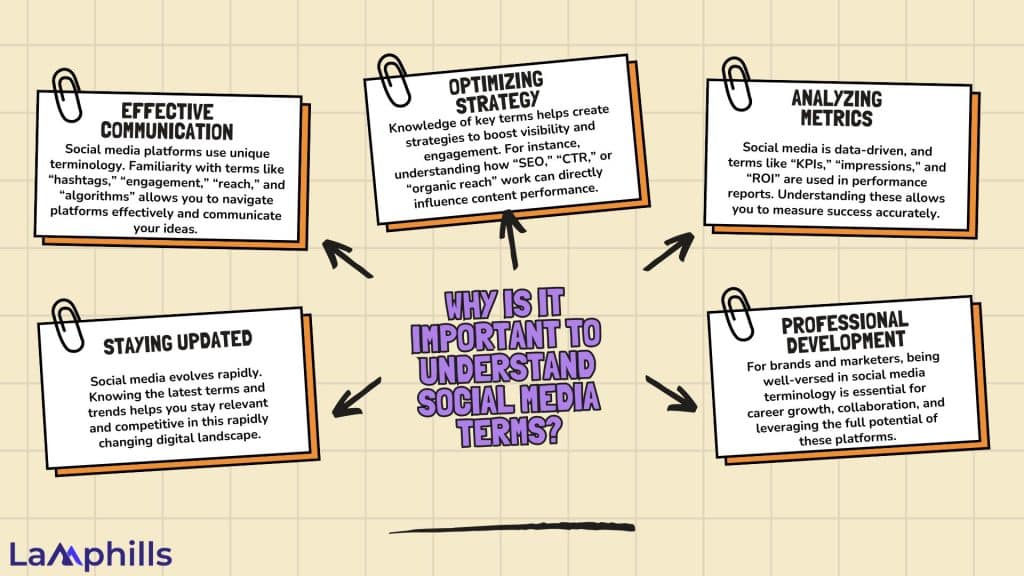Brands are always searching for new methods to improve their game on social media platforms in the ever-changing social media landscape. But here’s the catch. How can you win a game if you don’t know its rules and elements down to the last detail? So, social media terms are a crucial piece of this puzzle.
However, keeping up with the latest social media terms is essential to staying relevant to your audience, producing engaging content, and maintaining your social media presence. Trust me when I say that this doesn’t only influence your branding strategies but also how social media users perceive your brand.
This guide will explore the roots of must-know social media terms and terminologies related to engagement metrics. Come with me!
Key Points
- Social media terms refer to the commonly used words, phrases, and jargon specific to platforms like Facebook, Instagram, Twitter, and TikTok.
- Social media helps marketers make informed decisions, optimize their online presence, and build meaningful connections with their audience.
- Familiarity with terms like “algorithms,” “hashtags,” “engagement,” and “reach” helps brands navigate platforms more effectively and maintain a solid online presence.
What Are Social Media Terms?
Social media terms refer to the commonly used words, phrases, and jargon specific to platforms like Facebook, Instagram, Twitter, and TikTok. These terms help users and marketers understand key actions, metrics, and functions in the social media space.
By familiarizing yourself with these terms, you can effectively navigate and engage with social media. Using the terms correctly can help you build a solid online presence that resonates with your audience.
Why Is It Important to Understand Social Media Terms?

Understanding social media terms is crucial for several reasons:
- Effective Communication: Social media platforms use unique terminology. Familiarity with terms like “hashtags,” “engagement,” “reach,” and “algorithms” allows you to navigate platforms effectively and communicate your ideas.
- Optimizing Strategy: Knowledge of key terms helps create strategies to boost visibility and engagement. For instance, understanding how “SEO,” “CTR,” or “organic reach” work can directly influence content performance.
- Analyzing Metrics: Social media is data-driven, and terms like “KPIs,” “impressions,” and “ROI” are used in performance reports. Understanding these allows you to measure success accurately.
- Staying Updated: Social media evolves rapidly. Knowing the latest terms and trends helps you stay relevant and competitive in a fast-changing digital landscape.
- Professional Development: For brands and marketers, being well-versed in social media terminology is essential for career growth, collaboration, and leveraging the full potential of these platforms.
Top 19 Trendy Social Media Terms
Now that we have grasped the basis of social media terms and their importance, let’s explore the top trendy social media terms, which is the core reason for this guide.
#1. Algorithm
The set of rules a social media platform uses to rank and organize the content that appears in a user’s feed.
Most social media feeds once displayed posts in chronological order. But today, algorithms prioritize content based on its relevance to the user, among other factors.
Instagram, for example, determines what posts appear in each user’s feed based on the likelihood that the content will appeal to the user, the date the content was published, and the user’s previous interactions with the person who posted the content.
#2. Average Response Time
This term refers to how long your organization takes to respond to a customer on social media.
Facebook even has a feature that displays a business’ average response time.
Why is this important? Social media provides two-way communication between companies and customers, and today, your customers expect a timely response.

Nearly 80% of customers expect a response within 24 hours, and nearly 40% expect a reply within just one hour.
Responding to customers promptly, answering their questions, and addressing their concerns on social media helps that specific customer and your business because it drives brand loyalty. According to Bazaarvoice, 41% of shoppers view brands that respond to customers more favourably. Up to 70% of dissatisfied customers will do business with a brand again if their complaint is resolved.
#3. Bounce Rate
The percentage of visitors who click a link in your post but soon leave the page without viewing other pages or taking action. Regarding social media, the average bounce rate is about 50%.
The bounce rate is typically higher for social posts than other channels because users often view the content and then click back to their social feed to continue browsing. This is especially common when people access social media from mobile devices, which most do. That’s because most links open within the social media app, and users return to its main page.
#4. Click-Through Rate (CTR)
Click-through rate measures the percentage of users who click on a specific link or call to action within your social media content. It serves as a direct indicator of audience interest and engagement.
A high CTR indicates that your content is compelling and relevant to your audience’s interests. It points to your brand’s ability to capture your audience’s attention. By monitoring this metric, you can learn whether your content drives desired reactions from your audience.
#5. A/B Testing
A/B testing, or split testing, measures two social media posts against each other to see which performs best. It’s also known as split testing. The most common way of using A/B tests is to change only one element of the post between the two versions—such as the headline, image, CTA, etc.—so that you know any difference in performance is because of that change. You can A/B test with both organic and paid posts.
#6. Direct Message
A private message sent on a social media platform, such as Instagram, Facebook, or Twitter, that’s visible to the sender and the recipient only.
Each social network has its requirements for sending direct messages (DMs). For example, Twitter users can only send DMs to those who follow them. Many brands use DMs to communicate privately with dissatisfied customers who publicly tag them with complaints.

For example, it’s not uncommon for a user to tweet at a brand or comment on a brand’s post about an issue with an order. In these cases, you’ll often see the brand reply publicly, apologize for the inconvenience, and request that the customer DM their order details so they can resolve the dispute privately.
#7. Engagement Rate
Engagement rate is a social media metric that tells you how much a post motivates people to interact with it. It’s defined as (the number of people who engaged with your post/number of people who saw it) x 100%. A higher engagement rate typically means your post was more compelling (or at least more likely to provoke a response). Engagement rate is challenging to compare across social networks, as what counts as an “engagement” and what counts as “seeing your post” is different on each network. “Seeing your post” could refer to reach or impressions, while “engagements” may include likes, comments, shares, reactions, and more.
Read also: SOCIAL MEDIA ENGAGEMENT: How To Increase Your Engagement Rate
#8. Meme
A meme is a popular text, video, or image shared on social media platforms. It’s typically used for comical purposes, and users can create and share variations.
Companies also use the latest memes to engage or connect with younger audiences. Examples of popular memes that have been customized are the woman yelling at a cat and E.T. dressed as a woman with the words, “When you’re trying to look nice, but you haven’t slept in five years.”
#9. Hashtag
A keyword or phrase after a # that helps identify topics and organize conversations on social media.
Hashtags make it easy to find posts on a specific topic, such as #marketing, #beauty, #travel, or #employee advocacy. And social media marketers can use them to see what’s trending at a given time.
A branded hashtag is unique to your company and your organization—or social media users who want to tag you or participate in a conversation with your brand—use it.
Often, a branded hashtag features the organization’s full or partial name, such as Coca-Cola’s #ShareACoke or Buffy’s #InTheBuff. But countless successful branded hashtags don’t necessarily include the company name, such as REI’s #OptOutside and Spindrift’s #YupThatsIt.

Various hashtag-tracking tools are available to analyze hashtags and help you identify the best ones for your industry. Hashtags are also a phenomenal way for brands to find and gather user-generated content.
#10. Shadowban
A shadowban restricts a user’s content without their knowledge by not showing any of their content on others’ feeds. The user doesn’t know that other users can’t see their content. A shadowban occurs when a user violates a social media platform’s community guidelines or posts offensive or inappropriate content. Most social media platforms, including Facebook, Instagram, LinkedIn, Reddit, TikTok, and YouTube, have some form of shadowban.
#11. Key Performance Indicator (KPI)
A metric used to measure performance over time. In social media marketing, your KPIs allow you to track social goals and determine if your social media strategy is effective.
A variety of different KPIs can be used to measure performance depending on the goals of your strategy.
For example, if your goal is to increase engagement, you could use likes, comments, or the overall engagement rate as your KPIs. Or, if you want to expand your reach, you might use impressions, follower count, or audience growth rate as your KPIs.
Read also: KEY METRICS: Essential Metrics Every Business Should Have
#12. Pay Per Click (PPC)
An advertising model where the advertiser pays for each click their ad receives.
This model is typically used to drive traffic to a website.
PPC is often associated with search engines because advertisers bid on keywords relevant to their business and pay when those ads are clicked. The text-based ad below may appear when someone searches Google for “employee advocacy,” for example.

Advertisers can expect to pay $1 to $2 for each click for a Google ad, and the average small-to-medium-sized business spends about $9,000 to $10,000 on PPC advertising per month, according to WebFX.
#13. Influencer
Influencers sway consumers to buy a product or service by endorsing and promoting it on social media. They typically have specialized knowledge or expertise in a subject. People follow these influencers for their opinions, product reviews, and tips and tricks.
Influencers build a personal brand to attract followers. Popular influencers are field experts who can include celebrities such as Justin Bieber, Kylie Jenner, and Beyoncé. Famous influencers include Khaby Lame, Huda Kattan, Lauren Conrad, Cole Sprouse, and Salt Bae.
Influencers fall into various categories based on the number of followers they have. Here is a breakdown of the four types of influencers:
- Micro-influencers: 5,000 to 100,000 followers.
- Mid-tier influencers: 100,000 to 500,000 followers.
- Macro-influencers: 500,000 to 1 million followers.
- Mega-influencers: More than 1 million followers.
A clear contract is essential to work with influencers to amplify your brand’s reach. Our social media influencer contract template will help you outline expectations, deliverables, and payment terms to ensure smooth collaboration. Check it out below.
Lamphills Social Media Influencer Contract Template
#14. Sentiment Analysis
A subset of social listening that identifies and assesses how social media users feel about your business or product.
In other words, it takes people’s comments, reviews, and other types of feedback on social networks and puts them into context. Numerous sentiment-analysis tools are available today that make it easy to identify how a person feels about a product, service, business, or company’s content.
These tools allow social media marketers to automatically determine their audience’s mood and feelings about a brand.
Read more: Branding Sentiment Analysis: Everything You Should Know
#15. Creator Economy
A creator economy is a job market in which people use their skills and creativity to build their brands. This economy relies on social media to direct customers to a creator’s website or apps.
The creators are the founders of their brand, so these entrepreneurs have complete control of how they run their business versus a gig economy, which is backed by a company.
Examples of creator jobs include the following:
- Artist.
- Blogger.
- Course creator.
- Fitness coach.
- Life coach.
- Musician.
- Video blogger or YouTuber.
In addition, creators earn money through subscriptions, merchandise, product placement, fan clubs, advertising, and tipping.
#16. Social Selling
Developing and utilizing relationships during the sales process to help achieve sales goals.
This typically occurs on social media when salespeople share company content, interact with prospects, and answer potential customers’ questions about products and services.
Social selling results in more qualified leads, a better sales pipeline, increased sales, and larger deal sizes.
EveryoneSocial makes social selling easy. When Genesys tapped into its power, it increased its sales opportunities by 22% and grew its deal size by 165% in just one year.
#17. Return on Investment (ROI)
A measure of all the value your social media activity generates.
It’s calculated by dividing the value of your social media actions by the amount you spend to achieve them. Social media ROI can be challenging to estimate for several reasons.
For example, assigning an actual numeric value to a like or retweet is challenging. Also, not every social media objective can be easily measured. For example, measuring how your ad contributes to brand awareness isn’t as cut and dry as measuring the number of conversions an ad results in.
#18. Brand Advocate
People who are fans of your brand—inside and outside your organization—promote it organically via word-of-mouth marketing.
Brand advocacy increases your brand’s visibility, helps it reach larger audiences, and increases revenue.
It’s so effective because people trust endorsements from friends, family, and colleagues over those from brands. 92% of people trust these recommendations over any other type of advertising. That’s why it’s so important to transform your employees into the organization’s top advocates.
#19. Relevance Score
Relevance score is a metric available in Facebook Ads Manager that tells you how well your target audience responds to your ad on a scale of 1 to 10. The score is based on several factors, including positive feedback, such as clicks or likes; negative feedback, such as users selecting “I don’t want to see this ad,” and overall ad performance. The higher your relevance score, the more relevant your ad is to your target audience, and the more likely it will be selected over other ads to be shown to your audience.
Bottom Line
In today’s fast-paced digital world, mastering these top 20 trendy social media terms is more than just a vocabulary lesson—it’s your gateway to success. Understanding these terms empowers you to make informed decisions, optimize your online presence, and connect meaningfully with your audience.
As platforms evolve and strategies shift, staying fluent in this language gives you the agility to adapt, innovate, and thrive in the ever-changing social media landscape. Embrace these terms as buzzwords and essential tools to unlock your brand’s full potential.
Similar Articles
- The Best Media Planning Tools for Advertisers and Brands
- How to Become a Media Buyer in Nigeria in 2024






